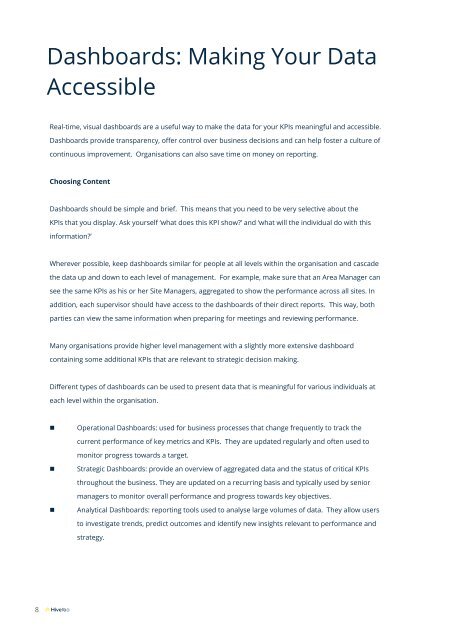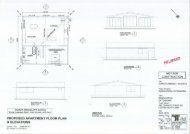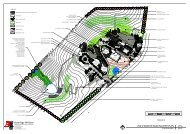Turning Your Data into Insights
You also want an ePaper? Increase the reach of your titles
YUMPU automatically turns print PDFs into web optimized ePapers that Google loves.
Dashboards: Making <strong>Your</strong> <strong>Data</strong><br />
Accessible<br />
Real-time, visual dashboards are a useful way to make the data for your KPIs meaningful and accessible.<br />
Dashboards provide transparency, offer control over business decisions and can help foster a culture of<br />
continuous improvement. Organisations can also save time on money on reporting.<br />
Choosing Content<br />
Dashboards should be simple and brief. This means that you need to be very selective about the<br />
KPIs that you display. Ask yourself ‘what does this KPI show?’ and ‘what will the individual do with this<br />
information?’<br />
Wherever possible, keep dashboards similar for people at all levels within the organisation and cascade<br />
the data up and down to each level of management. For example, make sure that an Area Manager can<br />
see the same KPIs as his or her Site Managers, aggregated to show the performance across all sites. In<br />
addition, each supervisor should have access to the dashboards of their direct reports. This way, both<br />
parties can view the same information when preparing for meetings and reviewing performance.<br />
Many organisations provide higher level management with a slightly more extensive dashboard<br />
containing some additional KPIs that are relevant to strategic decision making.<br />
Different types of dashboards can be used to present data that is meaningful for various individuals at<br />
each level within the organisation.<br />
• Operational Dashboards: used for business processes that change frequently to track the<br />
current performance of key metrics and KPIs. They are updated regularly and often used to<br />
monitor progress towards a target.<br />
• Strategic Dashboards: provide an overview of aggregated data and the status of critical KPIs<br />
throughout the business. They are updated on a recurring basis and typically used by senior<br />
managers to monitor overall performance and progress towards key objectives.<br />
• Analytical Dashboards: reporting tools used to analyse large volumes of data. They allow users<br />
to investigate trends, predict outcomes and identify new insights relevant to performance and<br />
strategy.<br />
8
















